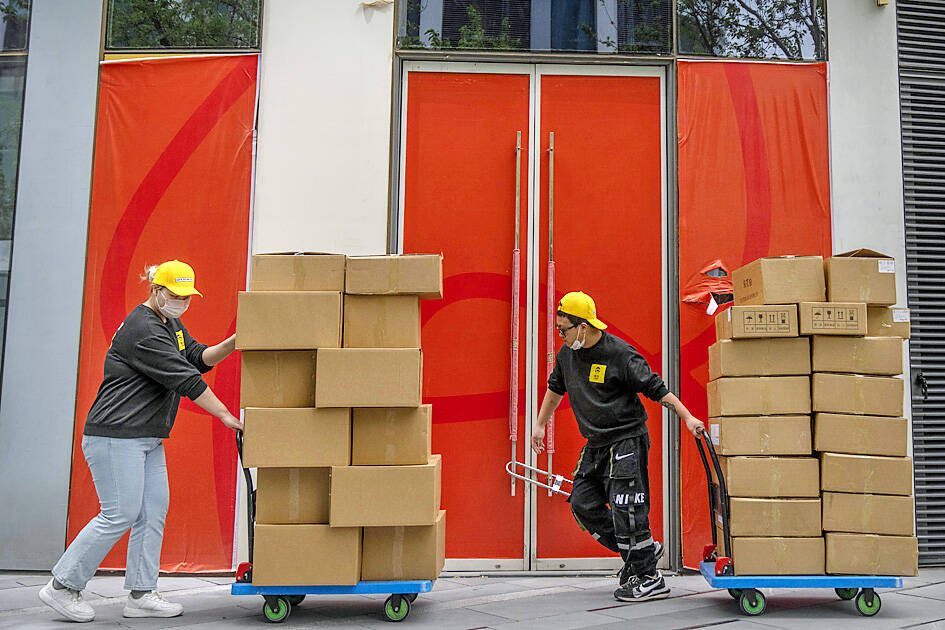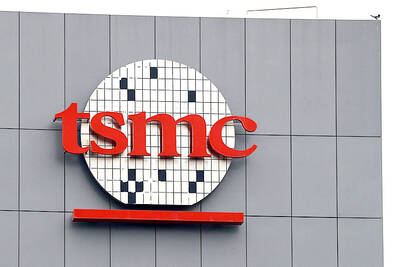Italy’s exports to China have tripled in little more than a year. The problem is, even the experts are struggling to explain why.
Shipments abroad rose above 3 billion euros (US$3.3 billion) in February, up 131 percent from a year earlier. This follows another jump of 137 percent the month before.
For comparison, Italy exported about 1 billion euros of goods and services in January last year to the world’s No. 2 economy.

Photo: AP
Such a boom would be hard to explain under normal circumstances. Now, as Russia’s war in Ukraine and supply-chain upheaval distorts traditional trade flows, it is downright mysterious.
First, consider the politics. Italy might be the only G7 country that has signed up to China’s mammoth investment plan, the Belt and Road Initiative, but the economic benefits of such an alliance since 2019 have been limited.
Moreover, relations had already cooled significantly under former Italian prime minister Mario Draghi. His successor, Giorgia Meloni, has signaled to US officials that she would pull out of the controversial China deal before the end of the year.
What makes the data even more puzzling is that it is all down to a specific sector: pharmaceuticals. To be more precise, “medicaments consisting of mixed or unmixed products for therapeutic or prophylactic uses, put up in measured doses.”
Exports of this group of products rose to 1.84 billion euros in February from 98.5 million euros a year earlier. They accounted for almost two-thirds of all Italian exports to China.
Why the spike? Italian media have speculated that the driving force is runaway Chinese demand for ursodeoxycholic acid (UDCA), a chemical used mostly in liver drugs and that has been claimed — without reason — to help prevent COVID-19.
So the sudden end of China’s “zero COVID” strategy and the subsequent wildfire spread of the virus across the country might be behind the export boom, although the vast majority of China’s population appears to have gotten COVID-19 in December last year and January, meaning they would have recovered before Italian exports started rising.
However, UDCA demand alone does not explain the export peak.
Industria Chimica Emiliana Srl, the Italian company that is the world’s largest integrated producer of UDCA and bile acid products, has yearly sales of about 300 million euros, just a fraction of the jump in Italian pharma exports to China.
Adding to the uncertainty, the most recent Chinese data yields little evidence these products are arriving en masse. Considering shipping times, the drugs — whatever kind they are — should have made it to China to be counted in last month’s trade data, but there was no observable change.
One explanation might be shifting regional trade.
“It’s likely demand for medicines from China,” said Peter Ceretti, a director at Eurasia Group who investigated the matter. “Larger Italian pharma producers are shipping as much Italian-made product as they can, and perhaps some are moving German and other European Union-produced medicine into Italy for re-export to China, too.”

STILL HOPEFUL: Delayed payment of NT$5.35 billion from an Indian server client sent its earnings plunging last year, but the firm expects a gradual pickup ahead Asustek Computer Inc (華碩), the world’s No. 5 PC vendor, yesterday reported an 87 percent slump in net profit for last year, dragged by a massive overdue payment from an Indian cloud service provider. The Indian customer has delayed payment totaling NT$5.35 billion (US$162.7 million), Asustek chief financial officer Nick Wu (吳長榮) told an online earnings conference. Asustek shipped servers to India between April and June last year. The customer told Asustek that it is launching multiple fundraising projects and expected to repay the debt in the short term, Wu said. The Indian customer accounted for less than 10 percent to Asustek’s

‘DECENT RESULTS’: The company said it is confident thanks to an improving world economy and uptakes in new wireless and AI technologies, despite US uncertainty Pegatron Corp (和碩) yesterday said it plans to build a new server manufacturing factory in the US this year to address US President Donald Trump’s new tariff policy. That would be the second server production base for Pegatron in addition to the existing facilities in Taoyuan, the iPhone assembler said. Servers are one of the new businesses Pegatron has explored in recent years to develop a more balanced product lineup. “We aim to provide our services from a location in the vicinity of our customers,” Pegatron president and chief executive officer Gary Cheng (鄭光治) told an online earnings conference yesterday. “We

LEAK SOURCE? There would be concern over the possibility of tech leaks if TSMC were to form a joint venture to operate Intel’s factories, an analyst said Taiwan Semiconductor Manufacturing Co (TSMC, 台積電) yesterday stayed mum after a report said that the chipmaker has pitched chip designers Nvidia Corp, Advanced Micro Devices Inc and Broadcom Inc about taking a stake in a joint venture to operate Intel Corp’s factories. Industry sources told the Central News Agency (CNA) that the possibility of TSMC proposing to operate Intel’s wafer fabs is low, as the Taiwanese chipmaker has always focused on its core business. There is also concern over possible technology leaks if TSMC were to form a joint venture to operate Intel’s factories, Concord Securities Co (康和證券) analyst Kerry Huang (黃志祺)

It was late morning and steam was rising from water tanks atop the colorful, but opaque-windowed, “soapland” sex parlors in a historic Tokyo red-light district. Walking through the narrow streets, camera in hand, was Beniko — a former sex worker who is trying to capture the spirit of the area once known as Yoshiwara through photography. “People often talk about this neighborhood having a ‘bad history,’” said Beniko, who goes by her nickname. “But the truth is that through the years people have lived here, made a life here, sometimes struggled to survive. I want to share that reality.” In its mid-17th to